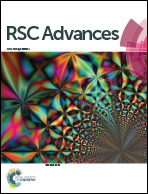DFT screening of metallic single-replacements for lead-free perovskites with intrinsic photovoltaic functionalities†
Abstract
Methylammonium lead triiodide perovskites, CH3NH3PbI3 (MAPbI3), are solution-processable materials with photovoltaic properties capable of surpassing those of silicon solar cells. However, concerns over lead toxicity and lack of exploration into transition metal perovskites drove this ab initio Density Functional Theory screening for environmentally friendly perovskite materials by incorporating transition and post-transition metals at the B-site of MAPbI3. This revealed fourteen replacements to be suitable: their band structures are highly dispersive while band gaps of such materials fall within ideal ranges for single-junction and tandem cells. Transition metal monoreplacements are shown to be viable perovskites after reducing the size of the halide, corroborating that tunability of the band gap is observed in halide replacement at the X-site. Strong peaks in the imaginary output of the dielectric function below 3.5 eV indicate high sunlight absorption efficiency for select materials. Excellent carrier mobility is expected of studied materials as their effective mass is low. This work helps gain further insight into the viability of transition metals for lower toxicity and higher absorption divalent perovskites.



 Please wait while we load your content...
Please wait while we load your content...